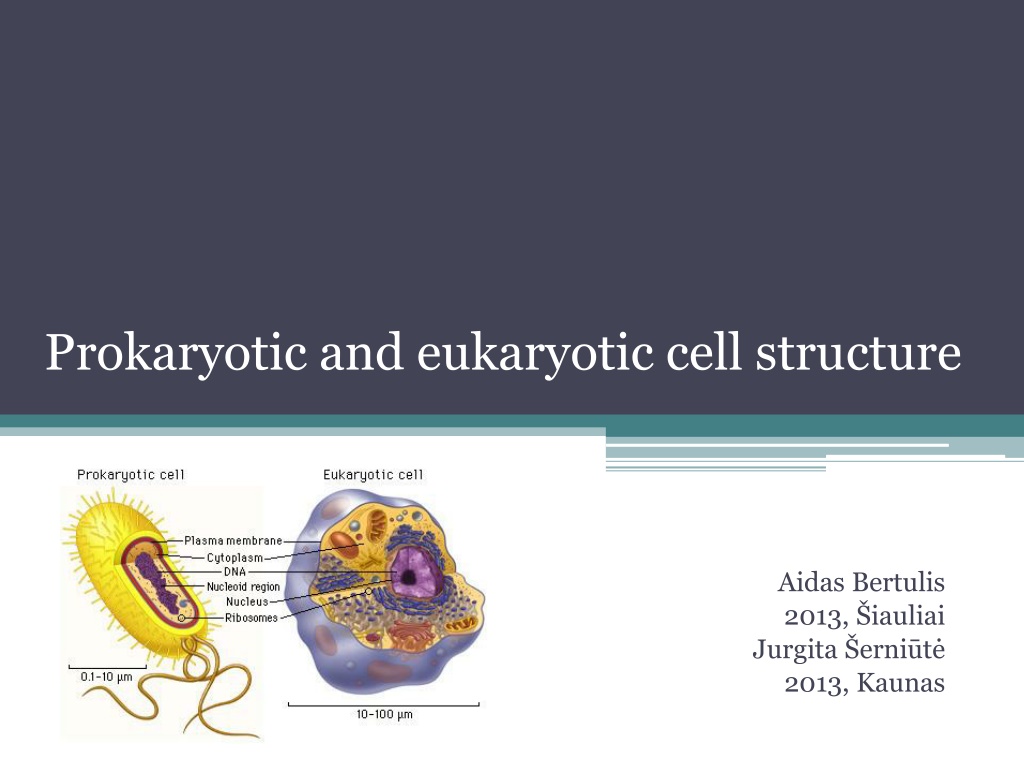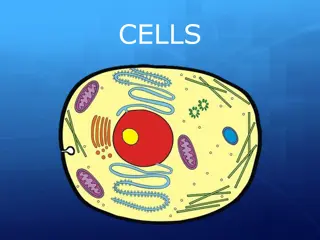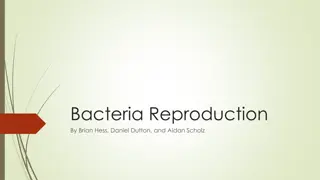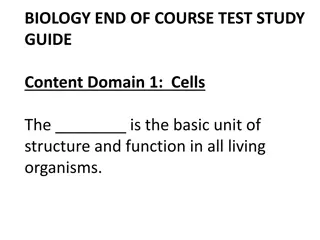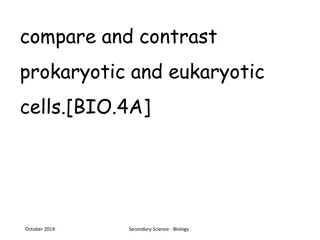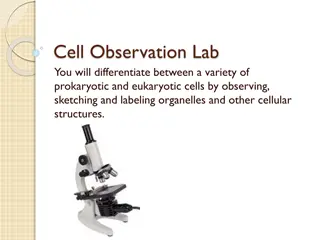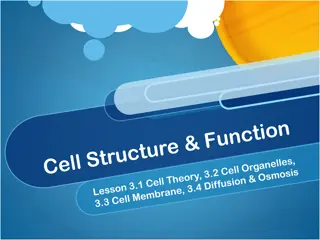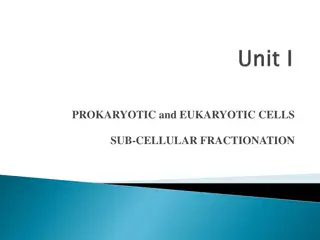Understanding Prokaryotic and Eukaryotic Cell Structure
This comprehensive guide explores the structures and characteristics of prokaryotic and eukaryotic cells. Learn about the differences and similarities between these cell types, including features like cell wall composition, membrane-bound organelles, nucleus presence, DNA structure, ribosomes, and more. Tasks include identifying cell types and understanding cellular components such as the plasma membrane, cytoplasm, ribosomes, nucleoid, flagella, and pili.
Download Presentation

Please find below an Image/Link to download the presentation.
The content on the website is provided AS IS for your information and personal use only. It may not be sold, licensed, or shared on other websites without obtaining consent from the author. Download presentation by click this link. If you encounter any issues during the download, it is possible that the publisher has removed the file from their server.
E N D
Presentation Transcript
Prokaryotic and eukaryotic cell structure Aidas Bertulis 2013, iauliai Jurgita erni t 2013, Kaunas
THE MAIN AIM: to learn about prokaryotic and eukaryotic cell structure. OBJECTIVES: 1. To learn the features of prokaryotic cell. 2. To learn the features of eukaryotic (animal) cell. 3. To learn to describe the differences and similarities of the two types. 4. To accomplish topic-related tasks.
Complete Task 1 : Indicate the cell type. Watch the video and fill in the table by matching the cell characteristics to the particular cell.
Answers Bacteria and cyanobacteria - prokaryote. All other cells - eukaryote. No nucleus - prokaryote. True nucleus - eukaryote. Lack membrane bound organelles - prokaryote. Possess subcellular organelles - eukaryote. Evolve from much smaller prokaryotic cells - eukaryote. Contain DNR - prokaryote and eukaryote. DNR is visible as a long irregularly shaped molecule - prokaryote. DNR is packaged together with special proteins called chromosomes - eukaryote. Specific number of chromosomes - eukaryote. Cell membrane, cytoplasm and various organelles - prokaryote and eukaryote. Have ribosome and make proteins - prokaryote and eukaryote.
Prokaryotic cell structure The general size of a prokaryotic cell is about 1- 2 um; Membrane bound organelles are absent; There is no true nucleus with a nuclear membrane; The ribosome's are smaller than those of eukaryotic cells; The slime capsule is used as a means of attachment to a surface. Only flagellate bacteria have the flagellum; Plasmids are very small circular pieces of DNA that may be transferred from one bacteria to another.
Cell Wall: Made of a murein (not cellulose), which is a glycoprotein or peptidoglycan (i.e. a protein/carbohydrate complex). Plasma membrane: Controls the entry and exit of substances, pumping some of them in by active transport. Cytoplasm: Contains all the enzymes needed for all metabolic reactions, since there are no organelles. Ribosome: The smaller (70 S) type are all free in the cytoplasm, not attached to membranes (like RER). They are used in protein synthesis which is part of gene expression. Nucleoid: Is the region of the cytoplasm that contains DNA. It is not surrounded by a nuclear membrane. DNA is always a closed loop (i.e. a circular), and not associated with any proteins to form chromatin. Flagella: These long thread like attachments are generally considered to be for movement.
Pili: These thread like projections are usually more numerous than the flagella. They are associated with different types of attachment. In some cases they are involved in the transfer of DNA in a process called conjugation or alternatively as a means of preventing phagocytosis. Slime Capsule: A thick polysaccharide layer outside of the cell wall, like the glycocalyx of eukaryotes. Used for sticking cells together, as a food reserve, as protection against desiccation and chemicals, and as protection against phagocytosis. In some species the capsules of many cells in a colony fuse together forming a mass of sticky cells called a biofilm. Dental plaque is an example of a biofilm. Plasmids: Extra-nucleoid DNA of up to 400 kilobase pairs. Plasmids can self- replicate particularly before binary fission. They are associated with conjunction which is horizontal gene transfer. It is normal to find at least one anti-biotic resistance gene within a plasmid.
Eucaryotic (animal) cell structure N:Nucleus PM: plasma membrane M: mitochondria rER: Rough endoplasmic reticulum GA: Golgi apparatus L: Lysosome MV: Microvilli
Nucleus: This is the largest of the organelles. The nucleus contains the chromosomes which during interphase are to be found in the nucleolus. The nucleus has a double membrane with pores(NP). The nucleus controls the cell s functions through the expression of genes. Some cells are multi nucleated such as the muscle fibre.
Plasma membrane: controls which substances can enter and exit a cell. It is a fluid structure that can radically change shape. The membrane is a double layer of water repellant molecules. Receptors in the outer surface detect signals to the cell and relay these to the interior. The membrane has pores that run through the water repellant layer called channel proteins.
Mitochondria: location of aerobic respiration and a majot synthesis of ATP region. Double membrane organelle. Inner membrane has folds called cristae. This is the site of oxidative phosphorylation. Centre of the structure is called the matrix and is the location of the Krebs cycle. Oxygen is consumed in the synthesis of ATP on the inner membrane The more active a cell the greater the number of mitochondria.
Rough endoplasmic reticulum (rER): protein synthesis and packaging into vesicles. rER form a network of tubules with a maze like structure. In general these run away from the nucleus The 'rough' on the reticulum is caused by the presence of ribosomes. Proteins made here are secreted out of the cell
Ribosomes: the free ribosome produces proteins for internal use within the cell. Golgi apparatus: modification of proteins prior to secretion. proteins for secretion are modified possible addition of carbohydrate or lipid components to protein packaged into vesicles for secretion
Lysozyme: Vesicles in the above diagram that have formed on the golgi apparatus. Containing hydrolytic enzymes. Functions include the digestion of old organelles, engulfed bacteria and viruses.
Complete: Task 2 Ascribe the cell characteristics to either plants or animals cell
References Click4biology. Internetin prieiga: http://click4biology.info/c4b/2/cell2.3.htm
Homeworks 1. Watch video retrieved from http://www.youtube.com/watch?v=1Z9pqST7 2is. NOTE start waching from 3:51! 2. Write the titles of cell parts. Take 4 new facts that you didn't hear today and present it next class.
Answer: 1 2 3 4 5 6 7 8 9 10 11 12 13 4 5 Cell structure
